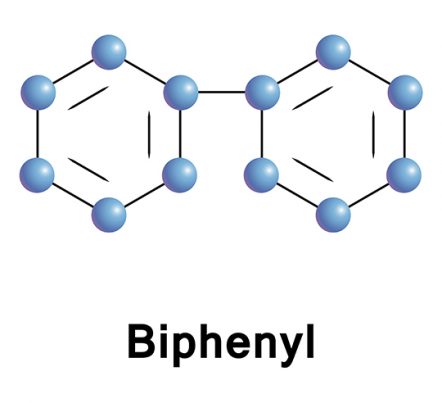
Biphenyl sources, health risks
Wednesday, October 18, 2017 by Janine Acero
http://www.naturalpedia.com/biphenyl-sources-health-risks.html

Biphenyl is an aromatic organic compound found in alcoholic beverages. It is a flavoring agent and food preservative, especially for citrus fruits, according to an entry published on Pub Chem. It is detected in bilberry, wine grape, carrot, peas, rum, potato, bell pepper, tomato, butter, milk, smoked fatty fish, cocoa, coffee, roast peanuts, olive, buckwheat, and tamarind. Biphenyl occurs naturally in coal tar, crude oil. and natural gas, and has been shown to have anti-coagulant and catabolic functions.
Harmful effects that may be caused by biphenyl
Exposure to high levels of biphenyl is known to cause fatal medical problems to the lungs when inhaled or ingested. Acute exposure to the colorless crystal triggers irritation upon contact with the eyes, nose, throat, mucous membranes and the respiratory tract.
Exposure to high levels of biphenyl vapors or dusts in the workplace causes inflammation of the respiratory tract, kidney disease, and liver damage. Some of the symptoms of biphenyl exposure, as reported on Toxicology Data Network, include cough, headache, flaccid paralysis, anorexia, nausea, vomiting or diarrhea, bronchitis, insomnia, depression, memory loss, facial paralysis, vertigo, numbness and aching of the extremities and fatigue.
Body systems harmed by biphenyl
High levels of biphenyl concentration is particularly hazardous to the eyes, nose, skin, and throat. The substance is also highly toxic to the respiratory system, liver, and central nervous system.
ScienceLab lists some first-aid tips after being exposed to, or making contact with, biphenyl:
- Eye contact — Remove any contact lenses and immediately flush eyes with running water for at least 15 minutes, keeping eyelids open. Get medical attention immediately.
- Skin contact — Remove contaminated clothing and shoes and immediately flush skin with plenty of water for at least 15 minutes. Cover the irritated skin with an emollient. Thoroughly wash and clean your clothes and shoes before reuse. Get medical attention immediately.
- Serious skin contact — Wash the area with a disinfectant soap and cover the contaminated skin with an anti-bacterial cream. Seek medical attention.
- Inhalation — If inhaled, remove to fresh air. If not breathing, give artificial respiration. If breathing is difficult, give oxygen. Get medical attention.
Where to learn more
Summary
Biphenyl is an irritant to the eyes, nose, throat and skin.
Biphenyl causes inflammation to the respiratory tract.
Biphenyl is highly toxic to the liver and kidneys.
Biphenyl is harmful to the respiratory system and central nervous system.
Sources include:
Tagged Under: Tags: Biphenyl






